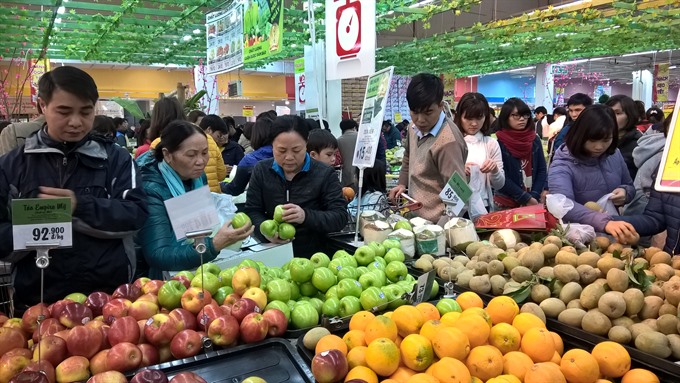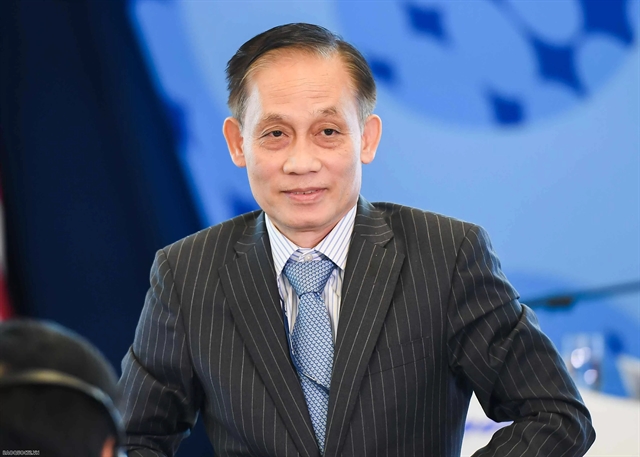 Economy
Economy

The domestic economy was stable in 2016, particularly toward the end of the year, after a slump in the first half, said Nguyễn Đức Thành, Director of the Vietnam Centre for Economic and Policy Research (VEPR).
 |
| Shoppers at a BigC supermarket in Hà Nội. The macroeconomic picture for 2016 was stable with some hope for 2017, said VEPR’s report. — Photo dantricdn.com |
HÀ NỘI — The domestic economy was stable in 2016, particularly toward the end of the year, after a slump in the first half, said Nguyễn Đức Thành, Director of the Việt Nam Centre for Economic and Policy Research (VEPR).
The VEPR’s macroeconomic report on the fourth quarter of 2016 and on the year in summary said Việt Nam’s economy showed signs of gradual recovery thanks to the manufacturing sector and stability in the agriculture sector, bringing the total annual growth rate to 6.21 per cent. The fourth quarter GDP recorded growth of 6.68 per cent, higher than that of the third quarter at 6.56 per cent.
The Việt Nam Economic Performance Index (VEPI) also rose significantly in the fourth quarter, reaching 6.53 per cent, 0.5 higher than in the third quarter, another indication of the economy’s strength.
With the purchasing managers index (PMI) maintained at over 50 points throughout 2016, an increase of 16.2 per cent in the number of newly established businesses and a 48.1 per cent increase in registered capital compared to 2015, the business sector had been a driving force for the economy.
Former Minister of Industry and Trade Trương Đình Tuyển also agreed that the business sector, chiefly manufacturing and processing, had grown steadily. But he noted that employment and new jobs had decreased slightly from 2015, indicating a less labour-oriented economic structure.
The agricultural sector, accounting for 11 to 13 per cent of total gross domestic product (GDP), only grew 0.72 per cent during 2016 and only contributed 0.09 per cent to total GDP growth, with aquaculture growing at 1.36 per cent, the lowest in the past six years.
Phạm Chi Lan, an independent economic researcher, said that the Government should focus more on agricultural development, as well as environmental protection and sustainable development.
Export turnover had a significant growth of 13.5 per cent, while import turnover had a growth of 16.1 per cent in the last three months of 2016, mainly due to price recovery.
The foreign exchange market stabilised after a year of applying the centre rate mechanism, though the exchange rates fluctuated wildly in the fourth quarter of 2016. Foreign exchange reserves continued to increase steadily in 2016, clocking in at a record $41 billion at the end of the year.
Monetary policy for 2016 was flexible and precise, with the State Bank of Việt Nam (SBV) staying close to the set inflation goal. Increases in capital flow, credit flow and capital mobilisation reached the planned figures set the by the SBV, while interest rates were kept stable thanks to the balance between capital and credit mobilisation. However, government control of inflation should be even more flexible in the coming year.
Decline in FDI
In addition to these mostly positive signs, other sectors of the economy declined, such as foreign direct investment disbursement with a slight downturn in the fourth quarter, despite a peak of US$15.8 billion in anticipation of the Trans-Pacific Partnership (TPP). FDI will possibly continue to shrink in light of plans by President-elect Donald Trump to abandon the TPP in 2017.
Furthermore, the Government budget deficit at 5.64 per cent of total GDP was still over the set goal, though less than the previous year. The deficit was still at a severe level, with spending increasing regularly and shifts in revenue.
Domestic gold price showed a discrepancy with world gold prices in the fourth quarter, as the latter dropped after the Federal Reserve decided to increase interest rates while the former rose due to anxiety over the dollar exchange rates.
The real estate market continued to grow compared to the middle of the year, with both price index, supply and number of transactions going up, though hope for this market is slim due to foreseeable anxiety over future interest rates.
Regarding the year 2017’s expectation, VEPR asserted that the growth target of 6.7 per cent set by the Government is somewhat improbable, with signs of inflation coming back making the inflation target of 4 per cent hard to achieve, as well.
Nonetheless, experts at the institute have high hopes for the business sector as the Government is determined to reduce legal procedures for entrepreneurs and improve the investment climate.
Lastly, budget control will continue to be a challenge with infrastructure requiring significant spending, and public debt will accumulate even further. VEPR advised the Government to crack down on unnecessary spending to maintain a budget balance in 2017, and to be alert to changing world economic developments.
VEPR has provided quarterly economic reports since the beginning of 2016, supported by the Ministry of Foreign Affairs and Australia’s Department of Foreign Affairs and Trade as part of a project of independent macroeconomic reports. — VNS




